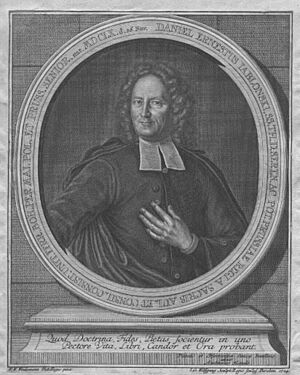Daniel Ernst Jablonski facts for kids
Daniel Ernst Jablonski (born November 20, 1660, in Nassenhuben, now Mokry Dwór, Poland – died May 25, 1741, in Berlin, Germany) was an important German theologian and reformer. He was of Czech background. He is best known for trying to bring together different groups of Protestants, especially the Lutherans and the Calvinists.
Contents
About Daniel Ernst Jablonski
Daniel Ernst Jablonski was born in a small village called Nassenhuben, which was near the city of Danzig (now Gdańsk) in Poland. His father, Peter Figulus, was a minister in a church group called the Unity of the Brethren. This group was also known as the "Bohemian Brethren."
Jablonski chose his last name, Jablonski, because it came from his father's birthplace, Jablonné nad Orlicí. He was the younger brother of another notable person, Johann Theodor Jablonski. His grandfather, Johann Amos Comenius, was a very famous educator and the last bishop of the Unity of the Brethren.
His Education and Early Career
Daniel Ernst Jablonski studied at two well-known universities: Frankfurt (Oder) in Germany and Oxford in England.
After finishing his studies, he started his career as a preacher in Magdeburg in 1683. From 1686 to 1691, he led the Brethren college in Leszno, Poland. This was the same position his famous grandfather, Comenius, had held.
Working for the Church and King
Jablonski was made a bishop for the Unity of the Brethren churches in Poland. Later, in 1735, he helped consecrate David Nitschmann as a bishop in Berlin. This was important for keeping the Moravian Church's traditions alive.
In 1691, he became a court preacher in Königsberg for Frederick III, who was the Elector of Brandenburg. A court preacher was a religious advisor to the king or ruler. Because of his position, Jablonski became very influential in the court. In 1693, he moved to Berlin and continued his work as a court preacher. In 1699, he was again consecrated as a bishop of the Unity of the Brethren.
Trying to Unite Protestants
In Berlin, Jablonski worked very hard to bring together the followers of Luther (Lutherans) and those of Calvin (Calvinists). These two groups were both Protestant but had some differences. The rulers of Berlin, Hanover, and other German states were interested in his idea.
Jablonski's main helper in this effort was the famous philosopher Gottfried Leibniz. Their goal was to create one big Protestant church that included German, English, and Swiss Protestants. They wanted to form "the one and same holy, catholic, and apostolic, and also evangelical and reformed Church."
For several years, they talked and negotiated to make this happen. However, they faced many challenges and it was very difficult to overcome them. Even though they didn't fully succeed, Jablonski and Leibniz never gave up believing that their goal was possible.
Jablonski also had another plan: he wanted to change the Church of Prussia by adding bishops and using some of the worship practices from the Church of England. But this plan also did not succeed.
His Academic Work
Besides his church work, Daniel Ernst Jablonski was also a respected scholar.
He created a version of the Old Testament in Hebrew. He also translated a book by Bentley called A Confutation of Atheism into Latin in 1696.
Jablonski also played a part in starting the Brandenburgische Societät der Wissenschaften, which is now known as the Prussian Academy of Sciences. He held many important positions at the Academy over the years. From 1700 to 1731, he was the secretary. He also served as vice president several times. Between 1710 and 1731, he was the director of the Philology and Oriental Studies sections, which focused on languages and cultures from the East. Finally, from 1733 until his death in 1741, he was the president of the Academy.
He also received a special degree from Oxford University.


